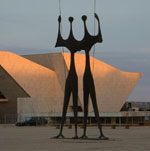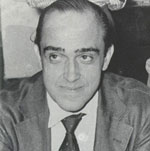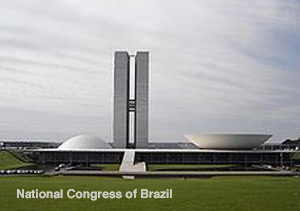
 Statue in honour of the labourers who built Brasilia  FRONT PAGE Site Search About us    City brand Amsterdam City brand Brasilia City brand Bucharest City brand Chicago City brand Hong Kong City brand London City brand Singapore City brand Tokyo Europe's top city brands EUROCITIES branding report - a critical review EUROCITIES on city branding Cities into successful brand Social media and government Top level city domain names Gallup's Soul of the City Mayor of London London City Hall  Worldwide | Elections | North America | Latin America | Europe | Asia | Africa |                           |
Conceived by an Italian saint, Brasilia
|
 Oscar Niemeyer Introducing Oscar Niemeyer Oscar Niemeyer was born in the city of Rio de Janeiro in 1907, on a street that later would receive the name of his grandfather Ribeiro de Almeida. He spent his youth as a typical young Carioca of the time: bohemian and relatively unconcerned with his future. He concluded his secondary education at age 21. The same year, he married Annita Baldo, daughter of Italian immigrants from Padua. Marriage gave him a sense of responsibility: he decided to work and enter university. He started to work in his father's typography house and entered the Escola de Belas Artes, from which he graduated as engineer architect in 1934. At the time he had financial difficulties but decided to work without fee anyway, in the architecture studio of Lúcio Costa and Carlos Leão. He felt unsatisfied with the architecture that he saw in the streets and believed he could find a career there. In 1945, already an architect of some repute, he joined the Brazilian Communist Party. Niemeyer was a boy at the time of the Russian Revolution of 1917, a young idealist during the Second World War and lived most of his life during the Cold War. He was enthusiastically communist, a position which would cost him much later in his life. During the military dictatorship of Brazil his office was raided and he was forced into exile in Europe. The Minister of Aeronautics of the time reportedly said that "the place for a communist architect is Moscow." He visited the USSR, met with diverse socialist leaders and became a personal friend of some of them. Fidel Castro once said: "Niemeyer and I are the last Communists of this planet." In 1939 Niemeyer travelled with Lúcio Costa to design the Brazilian pavilion in the New York World's Fair. At a time when Europe and the United States were concentrating their industrial powers on World War II, Brazil was investing in architecture. In 1940 Niemeyer met Juscelino Kubitschek, who was at the time the mayor of Belo Horizonte, capital of the state of Minas Gerais. He and Minas Gerais Governor Benedito Valadares wanted to develop a new suburb to the north of the city called Pampulha, and commissioned Niemeyer to design a series of buildings to be known as the ‘Pampulha complex’. In Pampulha, Niemeyer started to mark his style: he used the structural properties of the armed concrete to give sinuous forms to the building. When Niemeyer draws a building he makes it with the minimum of possible traces, as organic and trembling as a gesture of the hand. In 1947, his world-wide recognition was confirmed when Niemeyer travelled to the United States to design the headquarters of the United Nations in New York. In the previous year he had received an invitation to teach at Yale University; however, his visa was denied because of his socialist beliefs. Then Juscelino Kubitschek, elected president of Brazil in 1956, once again came in contact with Niemeyer. This time his plans were far more ambitious: he put Niemeyer in the head of Novacap, a project to move the national capital to a depopulated region in the center of the country. Niemeyer organized a competition for the urbanistic lay-out of Brasília, the new capital, and the winner was the project of his old master and great friend, Lúcio Costa. Niemeyer would design the buildings and Lucio the plan of the city. In the space of a few months, Niemeyer designed a large number of residential, commercial and government buildings. Among them were the residence of the President (Palácio da Alvorada), the House of the deputy, the National Congress, the Cathedral of Brasília, diverse ministries, not to mention residential buildings. Viewed from above, the city can be seen to have elements that repeat themselves in every building, giving it a formal unity. The cathedral of Brasília is especially beautiful, with diverse modern symbolism. Its entrance is a dimly-lit corridor that contrasts with the bright, naturally illuminated hall. The leftist position of Niemeyer would cost him much during the CIA-backed Cold War military dictatorship. His office was pillaged, the headquarters of the magazine he coordinated was destroyed, his projects mysteriously began to be refused and clients disappeared. The dictatorship in Brasil lasted 21 years. In the 1980s it softened and gradually turned into a democracy. At this time Niemeyer decided to return to his country. In 1988 Oscar Niemeyer was awarded the Pritzker Architecture Prize, together with the American architect Gordon Bunshaft. He designed at least two more buildings in Brasilia, small ones that are arguably among his greatest, the Memorial dos Povos Indigenas ("Memorial for the Indigenous People") and the Catedral Militar, Igreja de N.S. da Paz. In 1996, at 89 years old, he created what many consider his greatest work: the Niterói Contemporary Art Museum (in the city of Niterói, a city next to Rio de Janeiro). In 2003, Niemeyer was called to design the Serpentine Gallery Summer Pavilion in Hyde Park London, a gallery that each year invites a famous architect who has never previously built in the UK, to design this temporary structure. |
 Brazil’s capital was relocated to the Federal District in 1960, this being carved out of the state of Goiás in central Brazil. The Distrito Federal (designated as DF among the states’ initials) is the site of the nation’s legislature, chief courts and ministerial headquarters. Constisting of 26 states, the Brazilian constitution is heavily modelled on that of the United States. The previous capital was Rio de Janeiro, which remains the country’s best known city. It was designated the federal capital during the creation of the republic in 1889. However, following the relocation of the legislature, judiciary and civil service to Brasília, the former capital was designated as Guanabara state. In 1975 however, Guanabara merged with Rio de Janeiro to form one state.
Brazil’s capital was relocated to the Federal District in 1960, this being carved out of the state of Goiás in central Brazil. The Distrito Federal (designated as DF among the states’ initials) is the site of the nation’s legislature, chief courts and ministerial headquarters. Constisting of 26 states, the Brazilian constitution is heavily modelled on that of the United States. The previous capital was Rio de Janeiro, which remains the country’s best known city. It was designated the federal capital during the creation of the republic in 1889. However, following the relocation of the legislature, judiciary and civil service to Brasília, the former capital was designated as Guanabara state. In 1975 however, Guanabara merged with Rio de Janeiro to form one state.